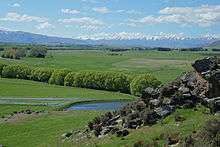Saint Bathans Fauna

The Saint Bathans Fauna, or St Bathans Fauna, is found in the lower Bannockburn Formation of the Manuherikia Group of Central Otago, in the South Island of New Zealand. It comprises a suite of fossilised prehistoric animals from the late Early Miocene (Altonian) period, with an age range of 19–16 million years ago. The layer in which the fossils are found derives from littoral zone sediments deposited in a shallow, freshwater lake, with an area of 5600 km2. The lake was bordered by an extensive floodplain containing herbaceous and grassy wetland habitats with peat-forming swamp–woodland.[1] At that time the climate was warm and the surrounding vegetation was characterised by casuarinas, eucalypts and palms as well as podocarps, araucarias and southern beeches. The fossiliferous layer has been exposed at places along the Manuherikia River and at other sites in the vicinity of the historic gold mining town of Saint Bathans. The fauna consists of a variety of vertebrates, including fish, a crocodilian, a sphenodont (the tuatara family), geckos, skinks, and several kinds of birds, especially waterbirds.[2] A basal form of kiwi, Proapteryx, is known from there.
Mammals
Uniquely in regards to modern New Zealand's dearth of land mammals there is a basal theriiforme mammal, the Saint Bathans mammal.[3] Several species of mystacine bats are also known.[4] This suggests that small land mammals were a common component of New Zealand's fauna in the Miocene.
Palaeognaths
New Zealand's two modern palaeognath clades, the kiwis and moas, have early representatives in the Saint Bathans fauna. The former is represented by the diminutive, possibly volant Proapteryx. The latter is represented by several bones and egg shells of currently unnamed species, but already identifiable as true moas, being large sized and flightless.[5][6] The fact that moas are already recognisably modern in anatomy, and possibly ecology, while kiwis are fairly unspecialised and probably still flighted, confirms the previous suspicions that neither clade is closely related and that they arrived in New Zealand independently: moas arrived and became flightless earlier in the Cenozoic, while kiwis were then recent Australian arrivals.[7]
References
- ↑ Worthy TH, Tennyson AJD, Jones C, McNamara JA, Douglas BJ (2007). "Miocene waterfowl and other birds from central Otago, New Zealand" (PDF). Journal of Systematic Palaeontology 5 (1): 1–39. doi:10.1017/S1477201906001957.
- ↑ Scofield, R. Paul; Worthy, Trevor H.; & Tennyson, Alan J.D. (2010). "A heron (Aves: Ardeidae) from the Early Miocene St Bathans Fauna of southern New Zealand.". In W.E. Boles and T.H. Worthy. (eds). Proceedings of the VII International Meeting of the Society of Avian Paleontology and Evolution (PDF). Records of the Australian Museum 62. pp. 89–104.
- ↑ Worthy, Trevor H.; et al. (2006-12-19). "Miocene mammal reveals a Mesozoic ghost lineage on insular New Zealand, southwest Pacific". PNAS. Retrieved 2007-08-23.
- ↑ Worthy, Trevor; Hand, SJ; Worthy, TH; Archer, M; Worthy, JP; Tennyson, AJD; Scofield, RP (2013). "Miocene mystacinids (Chiroptera, Noctilionoidea) indicate a long history for endemic bats in New Zealand". Journal of Vertebrate Paleontology 33 (6): 1442-1448.
- ↑ Worthy et al. 2007
- ↑ Tennyson et al. 2010
- ↑ Worthy, Trevor H.; et al. (2013). Miocene fossils show that kiwi (Apteryx, Apterygidae) are probably not phyletic dwarves (PDF). Paleornithological Research 2013, Proceedings of the 8th International Meeting of the Society of Avian Paleontology and Evolution. Retrieved 9 March 2014.
Coordinates: 44°54′S 169°54′E / 44.900°S 169.900°E